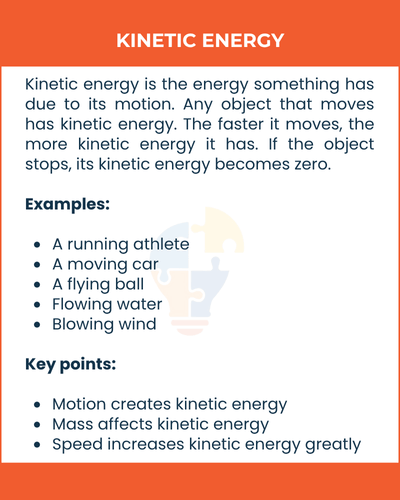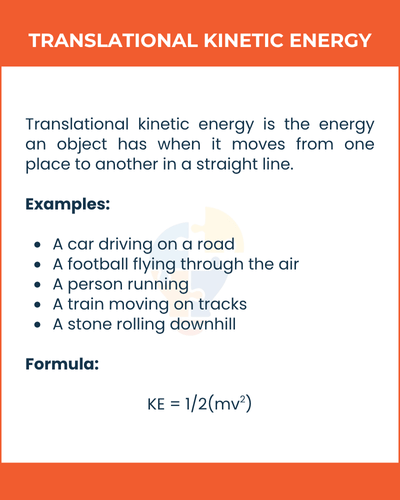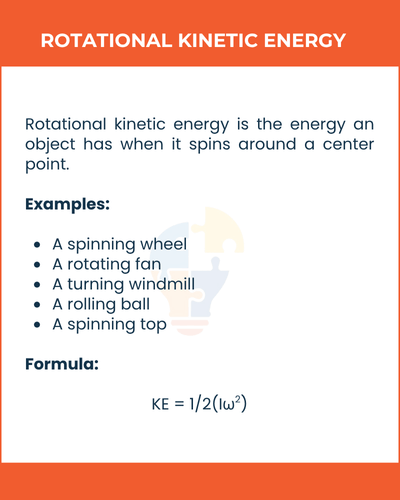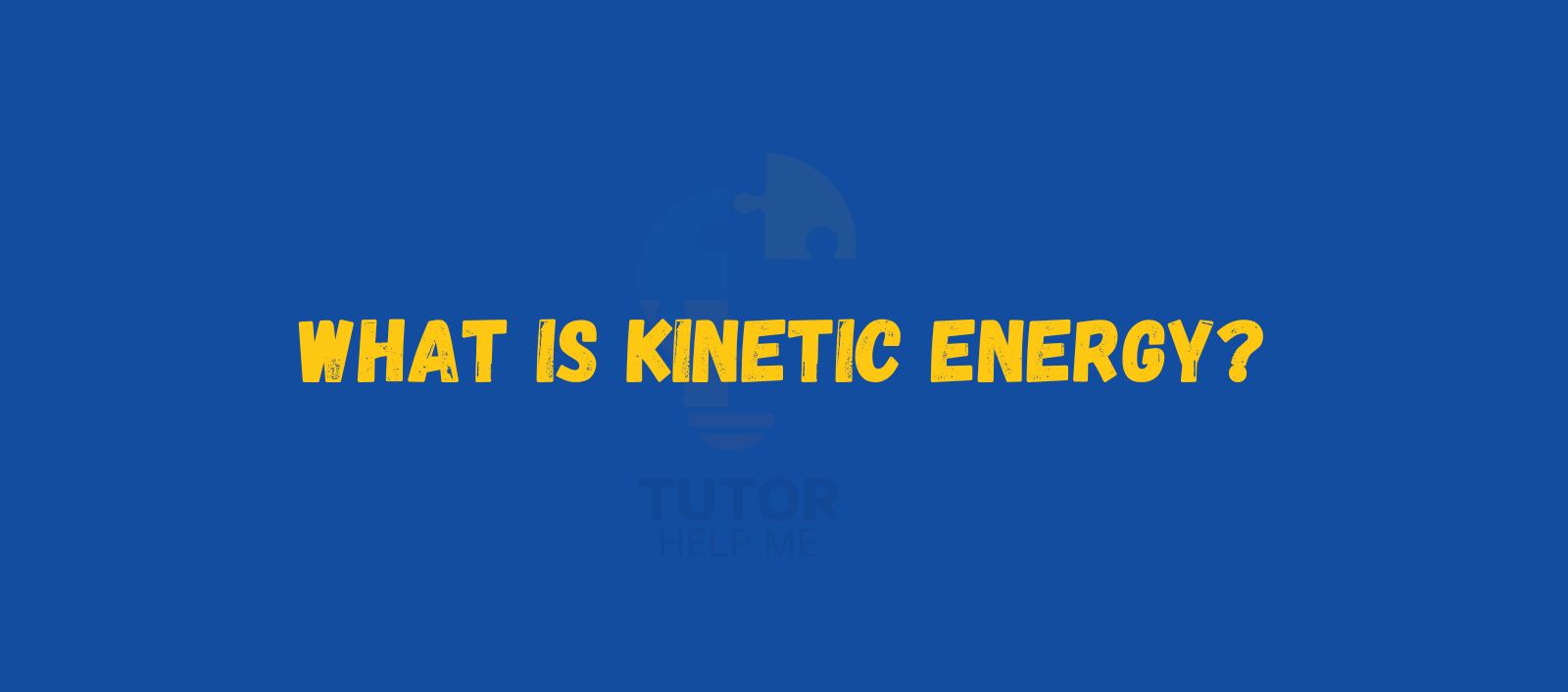Kinetic energy is the energy an object has because it is moving. This guide will help you understand what kinetic energy is, how it works, and why it is important in science.
You will learn formulas, types, transformations, and simple examples to make every idea clear.
Let’s begin by understanding the basic idea of kinetic energy.
What Is Kinetic Energy?
Kinetic energy is the energy something has due to its motion. Any object that moves has kinetic energy. The faster it moves, the more kinetic energy it has. If the object stops, its kinetic energy becomes zero.
examples
- A running athlete
- A moving car
- A flying ball
- Flowing water
- Blowing wind
Key points
- Motion creates kinetic energy
- Mass affects kinetic energy
- Speed increases kinetic energy greatly
Kinetic energy is one of the most important forms of mechanical energy and appears in daily life, machines, nature, and physics.

Kinetic Energy Formula and Equations
The formula for kinetic energy is:
KE = 1/2 (mv2)
Where:
- KE = Kinetic Energy (in joules, J)
- m = mass of the object (in kg)
- v = velocity or speed (in m/s)
Meaning of the formula
- If mass doubles → KE doubles
- If speed doubles → KE becomes 4 times
- Speed affects kinetic energy more than mass
Example
A 2 kg ball moving at 3 m/s:
KE = 1/2 (2)(32) = 9J
So the ball has 9 joules of kinetic energy.
Deriving the Kinetic Energy Formula
To understand where the formula comes from, we use simple physics:
Step 1: Work–energy idea
Work done on an object = Change in energy
W = F × d
Step 2: Replace force using Newton’s second law
F = ma
So, W = ma × d
Step 3: Use motion formula
v2 = u2 + 2ad
If the object starts from rest,
v2 = 2ad
So,
ad = v2 / 2
Now replace in work formula:
W = m(v2/2)
So,
W = 1/2(mv2)
Work = Kinetic Energy
KE = 1/2(mv2)
This shows that kinetic energy comes from the work needed to make an object move.
Types of Kinetic Energy
Kinetic energy comes in different forms depending on how the object moves. Below are the main types in simple words with examples.
a) Translational Kinetic Energy
Translational kinetic energy is the energy an object has when it moves from one place to another in a straight line.
Examples
- A car driving on a road
- A football flying through the air
- A person running
- A train moving on tracks
- A stone rolling downhill
Formula
KE = 1/2(mv2)
This is the most common type of kinetic energy.

b) Rotational Kinetic Energy
Rotational kinetic energy is the energy an object has when it spins around a center point.
Examples
- A spinning wheel
- A rotating fan
- A turning windmill
- A rolling ball
- A spinning top
Formula
KE = 1/2(Iω2)
Where:
- I = moment of inertia
- ω = angular speed

c) Vibrational Kinetic Energy
Vibrational kinetic energy happens when particles or objects move back and forth repeatedly.
Examples
- A guitar string vibrating
- Atoms vibrating in a solid
- Phone vibration motor
- Drum skin vibrating after a hit
- Sound waves moving in air
Every tiny vibration contains kinetic energy.
d) Thermal Kinetic Energy
Thermal kinetic energy is the energy of moving particles in matter.
Faster particles = more heat.
Examples
- Hot water with fast-moving molecules
- A heated iron rod
- Flames in a fire
- Air becoming warm
- Steam rising from boiling water
Thermal energy is a big part of heat science.
e) Electrical Kinetic Energy
Electrical kinetic energy is produced by moving electric charges (electrons).
Examples
- Electricity flowing in wires
- Lightning in the sky
- Current in batteries
- Energy in power lines
- Flow of electrons in circuits
This type of kinetic energy powers machines, devices, and homes.
Kinetic Energy Transformation
Kinetic energy often changes into other forms of energy or back into kinetic energy. Below are the most common transformations explained in simple words.
Elastic Collision
In an elastic collision, objects hit each other and bounce back without losing energy.
Examples
- Bouncing balls
- Newton’s cradle
- Pool balls hitting each other
Kinetic energy before and after the collision stays almost the same.
b) Pendulum Swing
A pendulum constantly changes energy between kinetic and potential.
At the highest point:
- Speed = 0
- Potential energy = highest
- Kinetic energy = lowest
At the lowest point:
- Speed = highest
- Potential energy = lowest
- Kinetic energy = highest
Examples:
- Clock pendulums
- Swinging playground swing
- Wrecking ball
c) Car Braking
When a car slows down, kinetic energy changes into heat energy through friction.
Examples
- Pressing the brakes
- Bicycle rim brakes
- Airplane landing brakes
This conversion is why brakes feel hot after use.
d) Wind Turbine
Wind has kinetic energy. The turbine blades absorb this energy and turn it into mechanical and electrical energy.
How it works
- Wind moves the blades
- Blades spin a rotor
- Rotor turns a generator
- Generator makes electricity
This is a major clean energy source today.
e) Waterfall
Water falling from a height has kinetic energy. This energy is used in hydroelectric power plants.
How it works
- Water stored in dams has potential energy
- Falling water becomes kinetic energy
- Turbines convert kinetic energy into electricity
This is one of the most powerful natural energy transformations.
f) Yo-Yo Transformation
A yo-yo constantly changes between potential and kinetic energy.
Motion cycle
- Dropping yo-yo: potential → kinetic
- Rising yo-yo: kinetic → potential
This cycle repeats every time the yo-yo moves up and down.
Conclusion
Kinetic energy is one of the most important forms of energy in physics and daily life.
It is the energy of motion, found in everything that moves, from falling raindrops to speeding cars, blowing wind, turning wheels, and even vibrating atoms.
By knowing the formula, types, and transformations of kinetic energy, we can understand how machines work, how nature moves, and how energy changes forms.
Kinetic energy helps engineers design safer vehicles, helps scientists study motion, and helps students learn the basics of physics with confidence.
Understanding what kinetic energy is gives us a strong base for learning more about motion, energy, and the world around us.
Read More What Is Kinetic Energy? Formula & Derivation
FAQs
What is kinetic energy in simple words?
Kinetic energy is the energy an object has because it is moving.
What factors affect kinetic energy?
Kinetic energy depends on the object’s mass and how fast it moves.
What happens to kinetic energy when speed doubles?
Kinetic energy becomes four times greater because speed is squared in the formula.
Can kinetic energy be negative?
No, kinetic energy cannot be negative because mass and speed cannot be negative.
Do stationary objects have kinetic energy?
No, objects that are not moving have zero kinetic energy.
What is the unit of kinetic energy?
The unit of kinetic energy is the joule (J).
How do we calculate kinetic energy?
We use the formula KE = ½ mv².
Does mass affect kinetic energy?
Yes. A heavier object has more kinetic energy if moving at the same speed as a lighter one.
Can sound have kinetic energy?
Yes. Sound waves have kinetic energy because they move through air.
Do atoms have kinetic energy?
Yes. Atoms move and vibrate, so they have thermal kinetic energy.
What type of energy is heat?
Heat is thermal kinetic energy from moving particles.
Does temperature affect kinetic energy?
Yes. Higher temperature means faster particles and more kinetic energy.
Is kinetic energy a type of mechanical energy?
Yes. Mechanical energy includes both kinetic and potential energy.
What happens to kinetic energy when a car stops?
It changes into heat energy through brakes and friction.
Is kinetic energy conserved in all collisions?
No. It is conserved only in elastic collisions.
Can kinetic energy turn into potential energy?
Yes. A swinging pendulum turns kinetic energy into potential energy and back.
What is rotational kinetic energy?
It is energy from an object spinning or rotating.
Is electricity a form of kinetic energy?
Yes. Electricity comes from moving electrons, which have kinetic energy.
What is an example of translational kinetic energy?
A moving car is the best example.
How is wind related to kinetic energy?
Wind is moving air, so it has kinetic energy that can turn wind turbines.
What is kinetic energy used for?
It powers engines, machines, vehicles, turbines, and many natural processes.
Does height affect kinetic energy?
Not directly. Height affects potential energy, which becomes kinetic energy when falling.
Is kinetic energy always visible?
No. Atoms and electrons also have kinetic energy even though you can’t see them move.
What is vibrational kinetic energy?
It is energy from objects vibrating, like guitar strings or air during sound.
What happens to kinetic energy in a waterfall?
It becomes mechanical and electrical energy in hydroelectric power plants.

